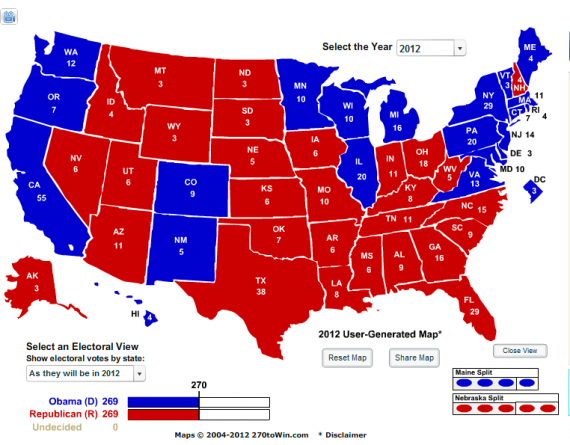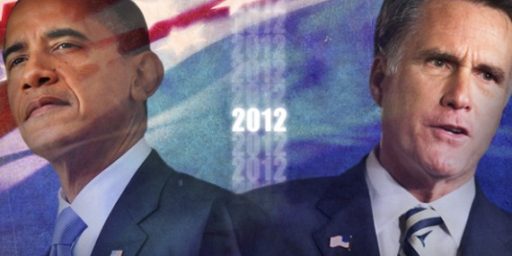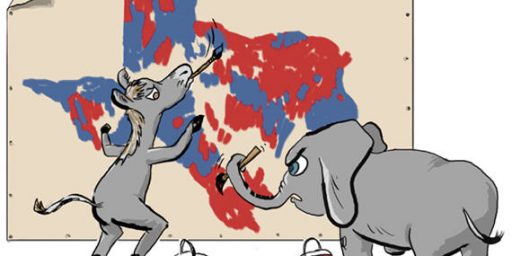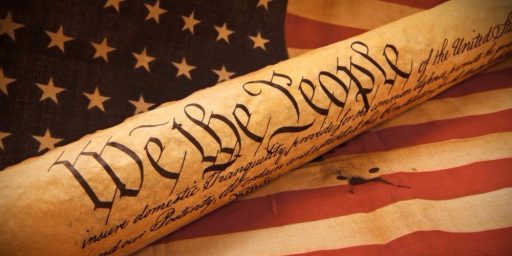Charlie Cook: Ignore The Electoral College Math
In his latest National Jounral column, Charlie Cook argues that we shouldn’t be paying as much attention to the electoral math as many pundits like to do:
The simple fact is that our nation has had 56 presidential elections. In 53 of them (94.6 percent), the winner in the Electoral College also happened to be the one with the most popular votes. Of course, we all recall the 2000 presidential election in which Al Gore prevailed in the popular vote, while George W. Bush was the Electoral College victor. But few remember that the previous divergence between popular and electoral votes was 112 years earlier, in 1888. Incumbent Grover Cleveland was the popular-vote winner. However, challenger Benjamin Harrison carried the Electoral College and was declared the winner. The only other time that happened was in 1876, when Samuel Tilden prevailed in the popular vote but Rutherford B. Hayes won the Electoral College vote and the presidency.
Two points are worth keeping in mind: First, the chances are about 94.6 percent that the same person will win both the electoral and popular votes. So people are expending a lot of time and energy trying to figure out something that has about a 1-in-20 chance of happening.
But second, close races are just that: close races. Notwithstanding the almost daily e-mails that I get protesting that the election will be a slam dunk for either Obama or Romney, this race will be close. Obama has a high floor, meaning that he has a fervent base of support. He also has a low ceiling, meaning that he has large and adamant opposition. That high floor has prevented him from descending to the depths of low job-approval ratings that afflicted many of his predecessors. Obama’s lowest Gallup job-approval rating was 40 percent, compared with George W. Bush’s low point of 28 percent; Jimmy Carter’s 29 percent; George H.W. Bush’s 32 percent; Ronald Reagan’s 37 percent; and Bill Clinton’s 37 percent.
If a race is close nationally, it will be close in a lot of individual states, too. Given the dubious quality of most of the publicly available state polling, few of these two-bit surveys could offer unique insight into who is likely to win close contests—because, well, they’re close.
Cook notes three exceptions, but there are actually four times when the winner of the popular vote did not become President;
- The Election of 1824 where Andrew Jackson an a popular vote majority and an Electoral Vote pluarlity, but John Quincy Adams was elected President by the House of Representatives;
- The Election of 1876 where Samuel Tilden won the popular vote but Rutherford B. Hayes won the Electoral College by a single vote;
- The Election of 1888 as Cook mentions; and,
- The Election of 2000.
Given the statistics, then, perhaps Cook does have a point that running through Electoral College scenarios doesn’t really tells us much more than looking at the national polls would, although it is fun for anyone who happens to be a political geek.
Incidentally, the Electoral College map above is one I created at 270towin.com that lays out a path to a tied Electoral College, which would force the election into the House of Representatives. Now, wouldn’t that be fun?







Actually, your map is not a distant possibility.
I think it would be completely spectacular if it went to court over a recount in say, Illinois, and Justice Roberts came through for Democrats (a kind of an NBA style even-up call for the Florida deal.)
@al-Ameda:
I have a hard time picturing a scenario where Romney wins in New Hampshire, but not in Virginia.
God god, that’s a scary prospect.
That said, your map also undercuts Cook’s argument a bit. It demonstrates that concentrating on the Electorial College, and as an extension, the three key swing states in particular – Florida, Ohio, and Pennsylvania – is probably the right approach.
As you and others have constantly stated, baring something truly unforeseen, the election is going to be decided in a few select states.
Cook is right about the state-level polling.
However, the fact of the matter remains, that there are large number of states where the outcome is pretty much a done deal. I would bet my house that Romeny will win Alabama, for example. And is there is any realistic scenario wherein Texas or CA goes differently than expected?
As such, it seems to me that the electoral college math, barring a highly unlikely year 2000 repeat, is the way to go here.
The real caveat should be: much can happen (in Europe, to name an obvious example) that could shift voter sentiment between now and November. Further, we really haven’t hit the main campaign season as yet.
Another thing that might throw a monkey wrench into the considerations is that the approval ratings might be drastically wrong for Bradley Effect, selection bias, or other reasons. I think that’s a very outside possibility that should not be completely discounted.
@Stormy Dragon:
I can’t disagree with you on that.
All I was saying is that Doug’s map is not completely farfetched, not likely, but not an infinitesimal possibility either.
Doug’s map seems to pretty accurate from what I can see (though, again, I’m not a pundit–but maybe that means I’m better.)
Couple of changes:
– Flip Virginia to Romney (I can’t imagine him losing here, honestly)
– Flip Wisconsin and Minnesota to Romney
– Flip Ohio and Indiana to Obama
– Give one of Nebraska’s votes to Obama
At least, that makes more sense to me. I could be totally wrong.
@Jeremy: Any scenario where Obama wins Indiana, but not Wisconsin seems suspect
I think that Charlie is drawing a flawed conclusion with regard to causation here. Of course the winner of the popular vote almost always wins the presidency. Winner take all electoral vote statutes at the state level make that a virtual certainty the vast majority of the time.
What he doesn’t spend as much time on is the fact that the margins in the electoral vote versus the popular vote do not neatly correlate. Because of those winner take all policies, the electoral vote is not representational of the popular vote, and as a result one can’t possibly hope to predict the result without considering the scenario on a state by state basis.
@Jeremy:
I agree that we can probably slot Virginia to Romney, although the growth in the DC burbs belt may result in a surprise pull out for Obama.
Minnesota is a lock, IMO, for Obama. Amalgamated polling has Obama up over 11 points in MN.
Wisconsin is a toss up. I’m not sure anybody can predict how it will flip, and the margin will be razor thin either way it goes. Likewise for Ohio. Both are polling within the margin of error, and have been for some time now.
Romney is polling up by 9 points in Indiana. Let’s go ahead and slot Indiana to Romney.
Agreed on one of Nebraska’s votes going to Obama.
@image:
Truthfully, any scenario that has Obama winning Indiana at all seems suspect to me.
I’m going to call my tossup states as being:
Colorado
Iowa
Missouri
Wisconsin
Michigan
Ohio
Florida
I think the others can probably be predicted with some level of confidence.
@Jeremy:
@HarvardLaw92:
Michigan will go for Obama, barring an unusual shift.
Indiana is pretty clear for Romney.
Obama seems securely ahead in Virginia.
Minnesota is solid Obama.
Obama is ahead in Ohio, though Romney has a chance.
Ditto Colorado and Wisconsin and Florida.
Romney ahead in Missouri and NC.
Iowa seems a real tossup ever so slight lean to Obama.
You could check out the summary of state-wide polls at RealClear Politics where they currently have Obama ahead 221 to 181 with 136 tossups. Delve into the polls and you see that a fair number of those are not really tossups but show some definite lean.
I have Obama at 332, Romney at 206 with no tossups.